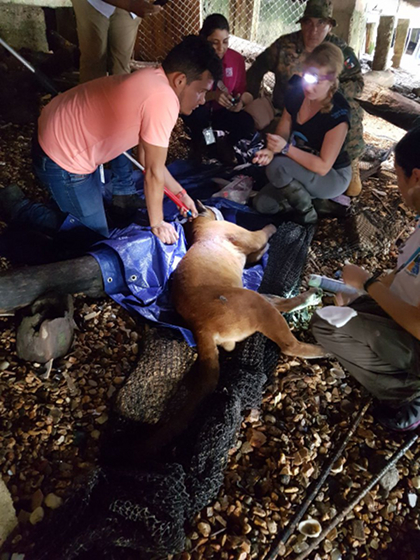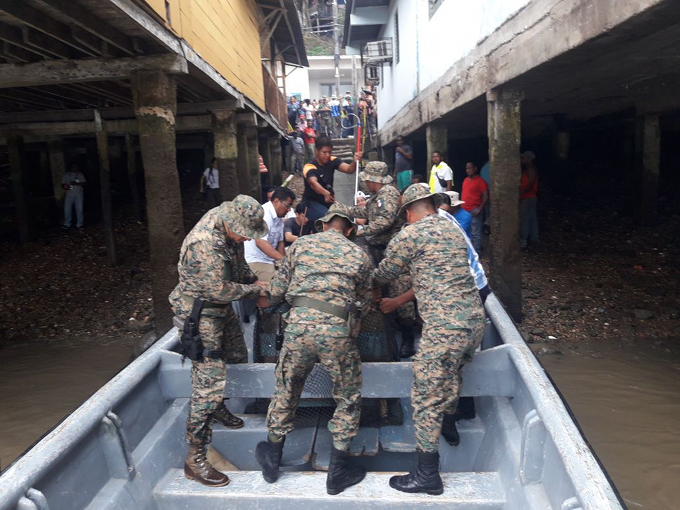Swimming into town. Video by Luis Casis
Puma swims into La Palma, setting off an inter-agency rescue
by Eric Jackson
photos and videos by SENAFRONT and MiAmbiente
Pumas are large wild cats, not the sort of animal that goes around eating people but certainly dangerous to people if they feel threatened and cornered by them. Their natural preference is to steer clear of human habitats, but when their own is diminished by the agricultural frontier the may feed on farm animals.
It was by no means an ordinary event when, on October 23, a puma swam into the Darien town of La Palma, located on the eastern shore of the Gulf of San Miguel, on the ocean end of this vast estuary that includes the Tuira and Chucunaque rivers and their tributaries and many smaller streams, many only navigable at or near high tide. This was an animal displaced from his forest habitat, and it may have been instinctive that landing, exhausted, where he did, he would try to hide in the trees. But the beach in La Palma is not a forest but a waterfront of houses and businesses built atop stilts on a steep slope where the sea rises and falls with the Pacific tides. Alerted by neighbors the local police — that’s the National Frontier Service (SENAFRONT), which is also a border patrol and the closest thing to an army that Panama has — went under the buildings to tranquilize and capture the puma and move him to a temporary safer place.
A couple of veterinarians from the Ministry of the Environment (MiAmbiente) were called in, and an ad hoc scientific, transportation and animal rescue operation ensued. The puma was fitted with a special tracking collar, designed to fall off and emit electronic pings after one year in order to be recovered along with data that it collects. Then he was taken out to the Chepigana Forest Reserve and released, in a place where it was estimated that he would get back to a more natural lifestyle. The whole operation took about three days.
The wild areas of Darien province are home to at least five species of jungle cats — that’s how many have been documented over the years, but with habitat destruction and climate change the ranges of many animals are changing. There’s always the chance that some cat that has never been seen in the area also lives there, or that some cat that used to live in the country’s easternmost province has gone locally extinct. Most probably the number is five, with SENAFRONT and MiAmbiente making an a effort to keep it at least that. The methods are to suppress poaching by education and law enforcement.
Are there still some trophy hunters out there? Actually there are, of a couple of main types. There are a few people who will shoot and skin jungle cats — strictly forbidden by Panamanian law — and show off or try sell their trophies. And then there are cops and park rangers, who will arrest such people and take photos of the suspects, the remains of animals that they have allegely killed and the weapons believed to have been used, as law enforcement trophy pictures meant to discourage others.
In this case, the two government agencies got publicity photos of their people doing a kind deed, people will learn a bit more about how and where these cats live and the puma got away with his life.



Concluye exitosamente operativo de rescate y reubicación en la Reserva Forestal de Chepigana del Puma bautizado con el nombre Palma. pic.twitter.com/qE5KbiVf8h
— MiAMBIENTE Panamá (@MiAmbientePma) October 25, 2017
~ ~ ~
These announcements are interactive. Click on them for more information.










